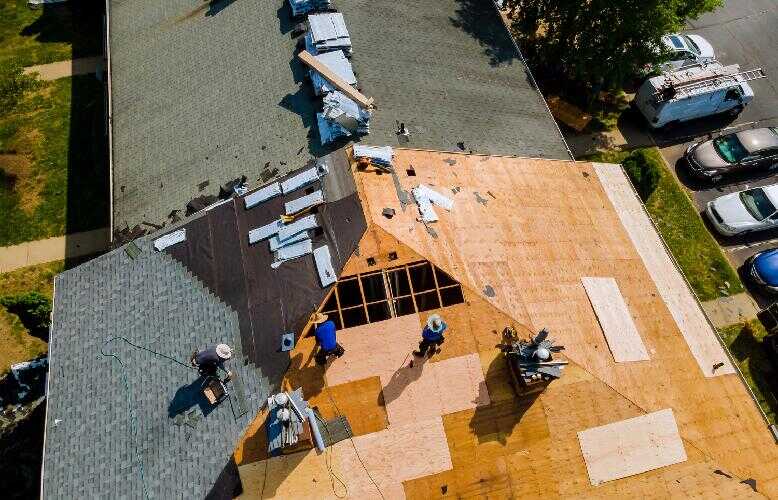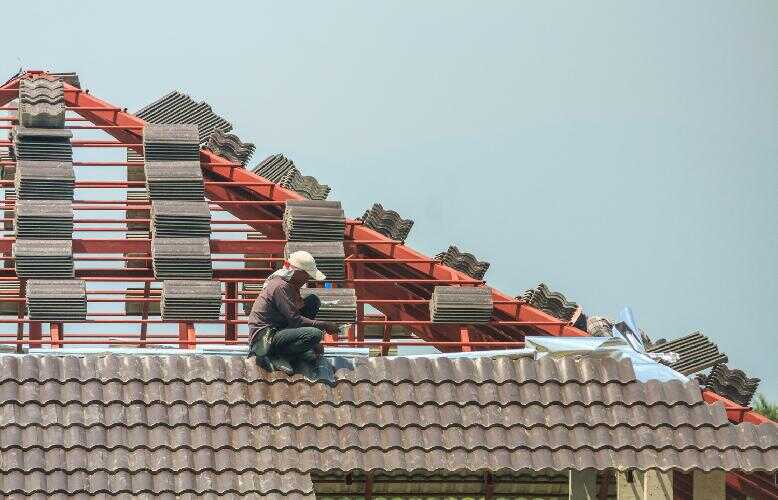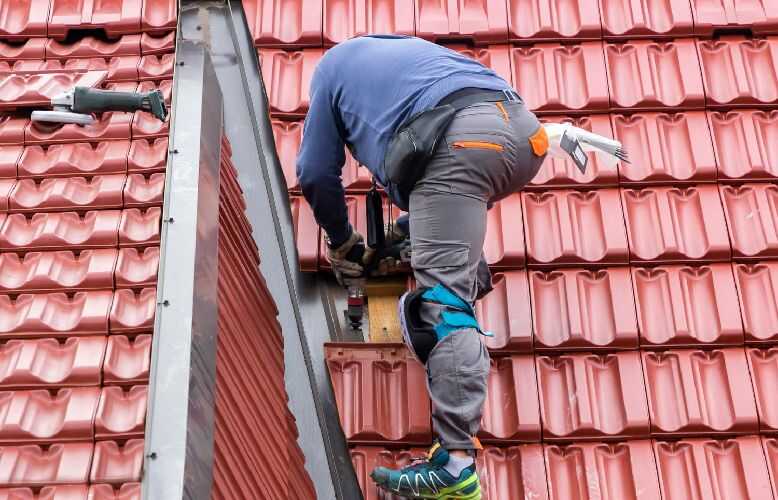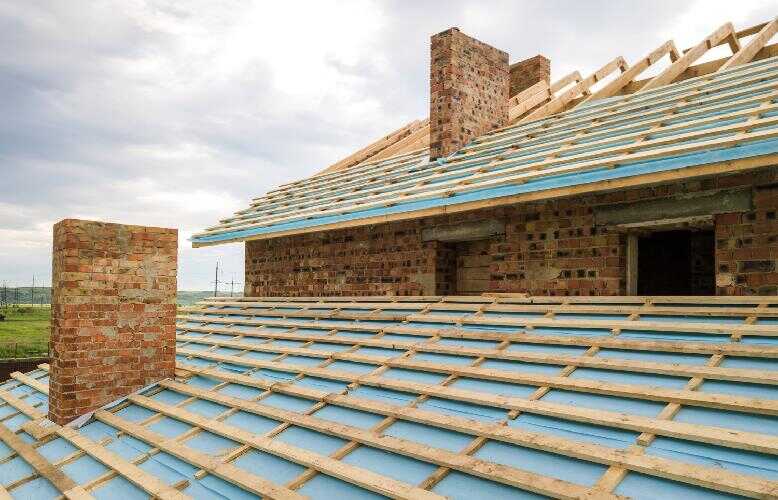We believe every roof presents an opportunity to make a lasting positive impact on your home, your wallet, and the planet. As concerns about climate change and energy consumption grow, homeowners are seeking practical ways to reduce their environmental footprint. Roofing projects are a smart starting point.
There is no need for eco-friendly roofing to be difficult or costly. Your next roofing project can be high-performing and sustainable with careful design and the appropriate materials. Every choice counts, whether it’s recycling old shingles or cutting down on energy use. Sustainable roofs assist communities nationwide by performing better, lasting longer, and adhering to green building regulations.
From material selection to design tactics and upkeep procedures, we’ll go over 20 simple and doable techniques to make your roofing projects more environmentally friendly in this article. Every homeowner can find something here, regardless matter whether they are repairing a few shingles or creating a brand-new roof from the bottom up.
1. Choose Cool Roofing Materials
Cool roofing materials lessen heat absorption by reflecting sunlight. This minimizes your energy costs and keeps your house cooler in the summer. The urban heat island effect is lessened by materials that reflect solar radiation, such as PVC, white TPO, and reflecting coatings. Cool roofing can result in energy savings of 10% to 30% during the hottest summer months by lowering the surface temperature of your roof by as much as 50°F. These materials also reduce heat-related deterioration, extending the life of your roof. This option can significantly increase indoor comfort if you live in a region where there is a high demand for a roofing contractor in Yonkers, NY.

2. Use Recycled Shingles
For roofing projects, recycled asphalt shingles (RAS) are a clever and environmentally responsible choice. These goods save raw materials and lessen landfill trash since they are made from post-consumer materials like recycled rubber and repurposed roofing tiles. RAS offers equivalent durability and performance to traditional shingles, frequently at a price that is equal to or less expensive.
Apart from their sustainability advantages, recycled shingles come in a variety of designs and hues, preserving curb appeal while reducing your environmental impact. You’re supporting a circular economy that encourages reuse and reduces waste by implementing RAS into your roofing projects.
3. Install Metal Roofing
Metal roofing is a long-lasting, energy-efficient option that complements environmentally friendly roofing projects. It is completely recyclable at the end of its life and has a lifespan of up to 70 years, which is significantly longer than a traditional shingle roofing installation in Yonkers, NY. Natural sunlight reflection from metal roofs, particularly when coated in light or cool hues, helps keep your house cool during the summer. This lowers energy consumption and the requirement for air conditioning. Because of its durability, recyclability, and energy-saving qualities, metal roofing has a smaller total environmental impact than traditional materials.
4. Opt for Sustainable Underlayment
Under your roofing projects, roofing underlayment serves as a moisture barrier. Selecting environmentally friendly underlayment solutions, such as plant-based materials, rubberized asphalt, or synthetic membranes, can increase sustainability without compromising performance. Compared to conventional felt, these goods are frequently more resilient to damp and more long-lasting. Your roof will be more resilient and have fewer negative environmental effects if you use non-toxic, long-lasting materials for your underlayment. An excellent underlayment is also essential for energy efficiency and insulation.
5. Incorporate Solar-Ready Design
Preparing your roof for future solar installations is a smart move in sustainable roofing projects. A solar-ready roof considers sun orientation, minimal shading, and structural integrity to support panel weight. Adding conduit pathways or designated mounting zones makes future upgrades easier and less invasive. By planning for solar early, you can save on future installation costs and increase your property value. Even if you’re not ready to install solar panels immediately, having a solar-ready roof helps ensure your home can adapt to renewable energy needs down the line.
6. Install Solar PV Panels
Installing solar photovoltaic (PV) panels on your roof allows you to generate your own electricity and reduce dependence on the grid. Solar panels can drastically cut utility bills and reduce your carbon footprint. Proper orientation, ideally facing south in the Northern Hemisphere, and a tilt that matches your location’s latitude, ensures maximum efficiency. While installation costs may seem high upfront, many homeowners recover their investment within 5 to 10 years through energy savings and tax incentives. Integrating solar panels into your roofing projects is a strong commitment to sustainability.
7. Harvest Rainwater with Roof Systems
Rainwater harvesting systems collect water from your roof and channel it into storage tanks or barrels. This water can be used for irrigation, landscaping, or even non-potable indoor uses. Designing your roofing projects to include gutters, filters, and first-flush diverters ensures clean water collection. These systems help reduce reliance on municipal water and conserve valuable resources, especially in drought-prone areas. By harvesting rainwater, you turn your roof into a tool for sustainability and resource conservation.
8. Use Green Roofing
Green roofing involves installing vegetation on your roof, transforming it into a living, breathing ecosystem. There are two primary types: extensive (low-maintenance, shallow soil) and intensive (deeper soil, supports shrubs and trees). Green roofs provide insulation, manage stormwater, and promote biodiversity. They also improve air quality and reduce noise pollution. While they require proper waterproofing and structural support, green roofs offer aesthetic beauty and significant environmental benefits. They are ideal for urban settings and can even extend roof life by shielding it from UV rays and temperature fluctuations.
9. Add Cool Roof Coatings
Cool roof coatings are reflective layers applied over existing roofing materials to reduce heat absorption. Elastomeric coatings are popular due to their flexibility and durability. These coatings can lower rooftop temperatures, extend the lifespan of roofing materials, and improve indoor comfort. Low-VOC versions ensure better indoor air quality during and after application. For homeowners looking to improve their current roof without a full replacement, cool roof coatings offer a cost-effective and environmentally friendly solution.
10. Improve Attic Insulation and Ventilation
Proper attic insulation and ventilation work together to make roofing projects more energy-efficient. Good insulation keeps warm air in during winter and hot air out during summer, reducing HVAC demand. Ridge vents, soffit vents, and radiant barriers help expel heat and moisture from the attic. This prevents structural damage and mold growth while enhancing indoor comfort. Together, these upgrades can significantly cut heating and cooling costs while extending the lifespan of your roofing system.

11. Use Low-VOC or Recycled Roofing Products
Many roofing adhesives, sealants, and coatings emit volatile organic compounds (VOCs) that harm indoor air quality. Choosing low-VOC alternatives reduces health risks and environmental impact. Additionally, using products with recycled content further supports sustainable construction. Look for products with third-party certifications such as GREENGUARD or LEED to ensure quality and safety. Incorporating these into your roofing projects supports both environmental goals and occupant well-being.
12. Maximize Natural Daylighting
Skylight installation services in Yonkers, NY, or solar tubes incorporated into your roofing projects introduce natural light into your home, reducing the need for electric lighting. These features improve mood and productivity while decreasing energy consumption. Choose energy-efficient glazing to minimize heat gain or loss. When installed properly, skylights and tubes offer excellent weather resistance and long-term savings. With smart placement, they can brighten interior spaces and enhance the livability of your home.
13. Design for Roof Overhangs and Shade
Strategic roof overhangs provide natural shade and protect against harsh sun exposure. In summer, they help cool your home by blocking direct sunlight from entering windows and walls. During winter, lower sun angles allow warmth to enter, improving energy efficiency. In hot climates, deeper overhangs or additions like pergolas can enhance thermal comfort. Well-designed overhangs also protect exterior finishes from weathering, extending the life of your home’s facade.
14. Use Local, Sustainable Materials
Sourcing roofing materials locally reduces transportation emissions and supports your regional economy. It also ensures compatibility with your climate and architectural style. Many local suppliers now offer eco-friendly options, including recycled content and sustainably harvested materials. Using regionally appropriate colors and finishes can help maintain neighborhood character and meet historical preservation requirements. Choosing local, sustainable materials for your roofing projects aligns environmental responsibility with community support.
15. Recycle Old Roofing Materials
Disposing of old roofing materials can add to landfill waste, but recycling programs exist for asphalt shingles, metal panels, and even wood shakes. Recycled shingles can be repurposed into paving or new roofing products, while metal can be sold as scrap. Recycling reduces environmental impact and may even offset some project costs. Clients are encouraged to ask about recycling options during roof replacements to minimize waste.
16. Maintain and Extend Roof Life
Regular maintenance is one of the easiest ways to make your roofing projects eco-friendly. Inspect your roof seasonally and after storms to catch minor issues before they escalate. Clean gutters, reseal flashing, and replace damaged shingles promptly. Proactive maintenance extends your roof’s lifespan and reduces the frequency of full replacements, saving resources and money. A well-maintained roof performs better, lasts longer, and supports overall home efficiency.
17. Optimize Gutter and Drainage Systems
Gutters play a crucial role in managing stormwater and protecting your foundation. Use systems that direct water into rain gardens, cisterns, or permeable paving. Downspout diverters can help collect water for reuse, while splash blocks prevent erosion. Optimizing drainage systems reduces runoff, supports plant health, and minimizes soil degradation around your home. As part of your roofing projects, improving gutter design is a simple but impactful sustainability upgrade.
18. Choose Sustainable Fasteners and Flashings
Small components like nails, screws, and flashing materials can have a big impact on sustainability. Choose corrosion-resistant options like stainless steel or copper for longer life and fewer replacements. These materials also resist harsh weather and reduce the likelihood of leaks or structural failures. Sustainable fasteners and flashings help ensure that your roofing projects remain durable, efficient, and environmentally responsible for years to come.
19. Consider Passive Solar Design
Passive solar roofing projects use building orientation, materials, and design to regulate indoor temperatures naturally. South-facing roofs with appropriate slopes can capture winter sun while avoiding summer overheating. Thermal mass materials and added insulation retain warmth during cold months. These strategies reduce reliance on mechanical heating and cooling systems. Passive solar design is especially effective in climates with significant seasonal temperature swings.
20. Use Smart Roof Monitoring Systems
Smart monitoring systems help homeowners track roof performance in real time. Sensors detect moisture, temperature changes, and structural movement, alerting you to potential issues early. This proactive approach minimizes repair costs and extends roof life. These systems also help measure energy savings from upgrades like solar panels or insulation. Incorporating smart tech into roofing projects improves efficiency, comfort, and long-term performance.

Why Choose Perfect Contractor Group for Eco-Friendly Roofing Projects?
At Perfect Contractor Group, we believe that roofing is about progress. As sustainability becomes a priority for homeowners across the country, we’re proud to lead the way in eco-conscious roofing solutions that reduce waste, conserve energy, and support long-term environmental health.
What sets us apart is our holistic, future-focused approach to every roofing project. Whether you need chimney flashing services in Yonkers, NY, explore recycled materials, or upgrade ventilation for energy efficiency, we bring experience, certified green building knowledge, and top-tier craftsmanship to the table.
We work with locally sourced, sustainable materials whenever possible and are committed to low-VOC, recyclable products that meet both performance and environmental standards. From planning to installation, we help you make smart, sustainable choices without compromising on style, durability, or budget.Most importantly, we treat your home like it’s our own. That means transparent communication, responsible waste management, and a genuine commitment to helping you create a roof that performs beautifully and supports a greener tomorrow. Choose Perfect Contractor Group for your next project, and build more than a roof, build a better future. Contact us now.



